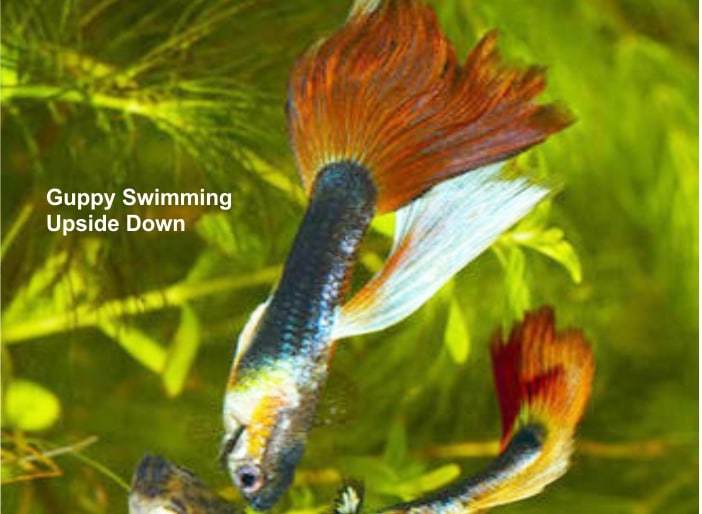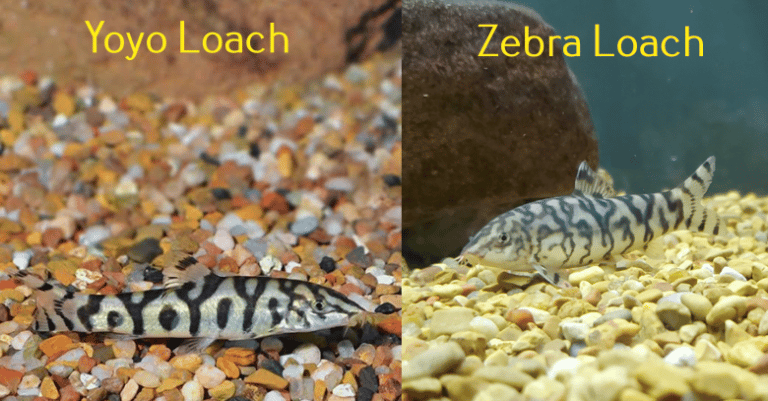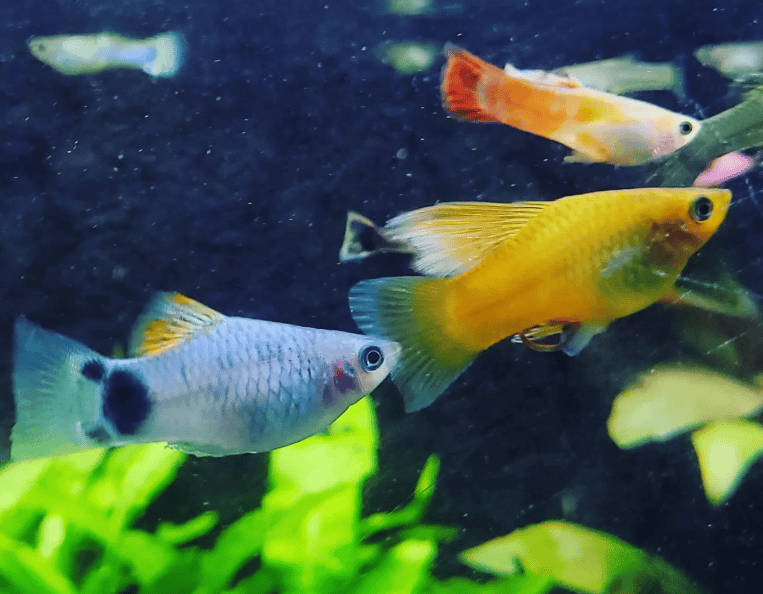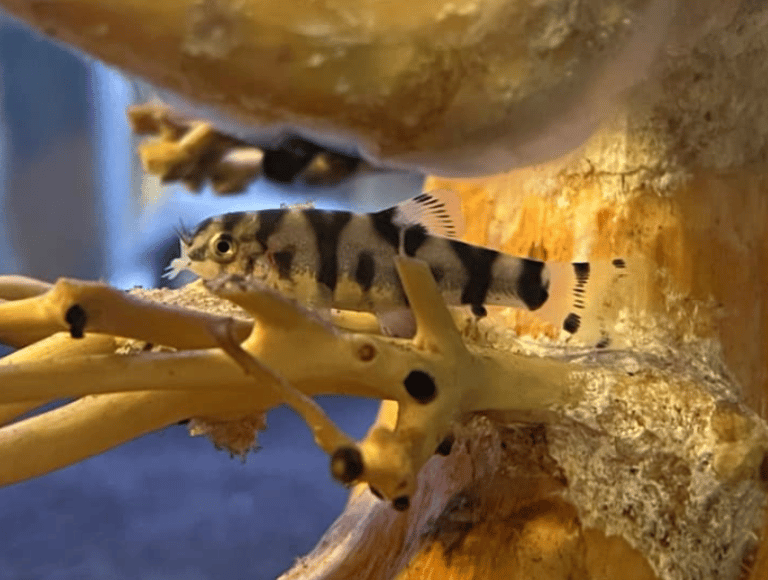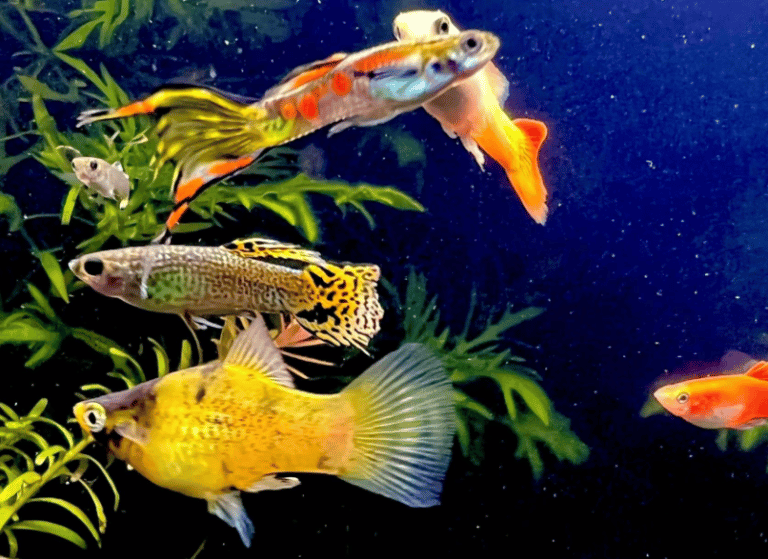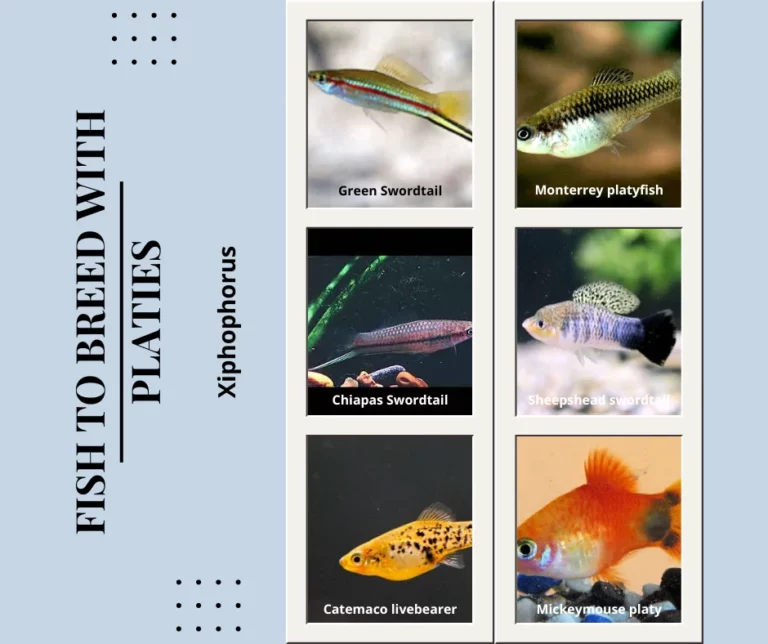Generally, guppies are peaceful, social fish. But, it is also true that wild guppies have been linked with cannibalistic behaviors in their natural aquatic environment. That includes attacking and killing their young ones if there is no food.
Guppies abandon their peaceful and social nature and resort to cannibalism when the tank conditions are hostile. For instance, if an aquarium is overcrowded with less food, guppies may attack and eat each other for survival.
Signs of guppy guppies cannibalism include;
- Severe injuries and wounds on them.
- Dead guppies with bite marks.
- Young ones keep disappearing.
- Remains of dead fry at the bottom of the tank.
- Scared guppies spend a lot of time hiding.
- Extra chasing and swimming in panic mode among them.
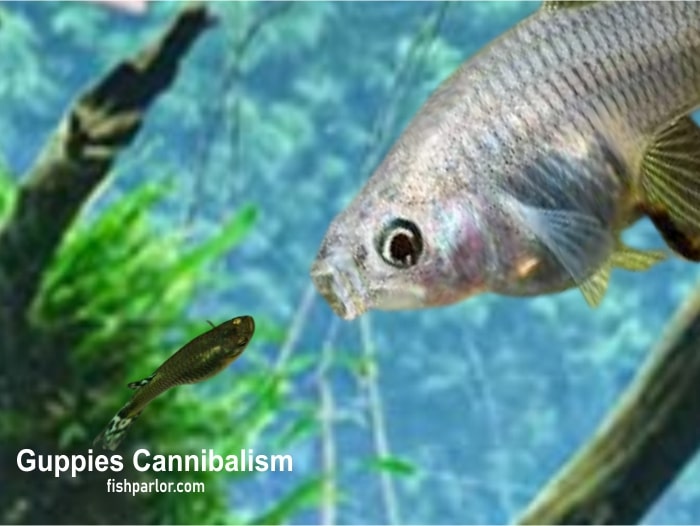
Do guppies eat their babies?
Guppies can eat their babies if they lack enough food in the tank. This act is referred to as filial cannibalism. If the young ones disappear without an explanation, the large males and females may eat them. In such a scenario, you may only find their remains, i.e., Fins/tails floating on the water.
Cannibalism is common in their natural habitats compared to a controlled environment like an aquarium. Many species in the animal kingdom eat their offspring.
Even as scientists are still studying the reasons behind filial cannibalism, here are some of the reasons why guppies can eat their babies;
- Guppies may feed on their babies if they are desperate for food.
- Adult guppies confuse their babies for food due to their tiny size.
- In their natural habitats/wild, full-grown guppies prefer feeding on small, protein-rich food sources like brine shrimps, micro worms, and water fleas. If they lack those, they may feed on their young ones.
- A guppy can eat its fry to cope with depression, frustration, and stress.
Myths and beliefs about Guppy cannibalism
In a single pregnancy, a guppy can deliver 30-60 babies. So, to improve mental well-being and boost the instinct of self-preservation, guppies will eat their offspring. Admittedly, the stress or frustration factor is not a convincing explanation for guppies eating the fry. Even guppies without stress will eat their babies.
There are also beliefs that some guppies eat their babies to allow the living and survival of only stronger guppy babies. Since guppies give birth to numerous guppy babies, some weaker ones will have genetic issues. Offspring eaten do not have survival instincts and are too weak to swim, thrive, and defend themselves.
It is also possible for filial cannibalism to exist to control the population of guppies. By eating their babies, overpopulation does not become a problem.
From the explanations, it is clear that guppies do not eat their babies for fun or because of hunger. However, female guppies may fight off and even harm their mates in the tank if their young ones are threatened.
Do guppies eat their dead ones?
Guppies can eat their own, if dead or alive. They can also do so to other species as long as they need to and if they can. Guppies will always move around in search of food if there is scarcity. When they find dead bodies of their own or others, they try to bite or eat them.
If a dead guppy is in a tank, remove it as soon as possible. Investigate and find the causative factor so that the rest are safe. Always feed them well, so they do not have a taste or crave their own, whether alive or dead.
Dead fish will rot when left too long inside the tank. That contributes to poor water conditions. The rotting of dead guppies or other tank mates produces poisonous gasses like ammonia and nitrite.
Other guppies can attack one of their own, kill, and eat it. Guppies attack one of their own due to overcrowding, lack of enough food, and threat to territory. The presence of more males than females in the tank can also cause the attacks.
Do guppies eat other guppy tails?
Guppies can bite or nibble others, especially on their tails or fins. Aggressive male guppies constantly harass and nip the long-flowing tails of other weak males until they are damaged. Males can also eat other guppies if they are a threat, competitors for territory, or female scarcity.
Additionally, guppies will starve if you are not providing enough food. Consequently, expect to see them attacking, killing, and eating each other. Generally, an attacked guppy dies because of stress and infections from injuries. Ensure you discourage bullying, fighting, or aggressive behavior in an aquarium.
Adult guppies need to feed at least twice daily. On the other hand, guppy babies must eat more than five times daily as they require more food for body development. For that reason, guppy fish spend most of their time searching for food, especially at the bottom of the aquarium or tank.
Bullying may not be dangerous unless it occurs repeatedly and leads to a severe infection. Constant biting of tails and fins mostly happens in a tank with only males. Bullying can also occur when you mix stronger and weaker male guppies in a tank. This is one of the main reasons some weak or tired fish may breathe fast due to stress and fear of attack.
How to stop guppy cannibalism
When you notice cannibalism signs, separate the dominant, cannibalistic fish from the rest of the stock. A fish that is nipped and bullied can have severe injuries and stress. Poor health and general well-being lower the ability of the body to defend itself against attacks by diseases and infections.
1. Searate a pregnant guppy
Check for signs of pregnancy in guppies, such as the darkening and enlargement of the gravid patch. Guppies give birth almost every month. Transferring a pregnant guppy to a breeding box or separate tank reduces the chances of cannibalism. A pregnant guppy is weak and cannot defend itself against other guppies trying to eat or nip it.
The new tank you set up for a pregnant guppy should have the proper water parameters, temperature, and pH. Use test strips to check the water pH. The best water range is pH 6.8-7.8. If you want to know the water temperature use a thermometer. Keep the temperature range between 22-28 °C.
The water heater is for keeping the water temperature relatively warm for the safe living of guppies.
2. Use live plants and other decorations
Live plants and other decorations in the tank create great hiding spots. So, weak guppies can use those hideouts to escape from aggressive tank mates that can hurt them. Duckweed is one of the most preferred live plants for fish tanks because it has extensive sprouting leaf growth.
3. Separate the baby guppies
Since guppies that have given birth may eat their fry or babies, transfer them to another tank immediately after they are born or hatched. Use a fish net to collect and carry the fry.
Provide food regularly, maintain clean water, and eliminate other sources of stress. If you have added decorations in the tank, ensure they are not pointed or rough to prick and hurt the young ones.
4. Separate the aggressive ones
Do not keep the aggressive ones with the weak ones. Avoid the scare and tension by separating them. If you have only guppies in the tank, check if the ratio of males to females is correct.
Overcrowding of guppies is sure to trigger aggressive and fighting behaviors. It causes fights for mating mates, food, and territory.
You should not mix guppies with fish species with long fins and tails. Gouramis and bettas tend to consider bettas as threats because of their fins and tails. Thus, gouramis and bettas may attack and eat bettas.
5. Provide enough food
An adequately fed guppy will not attack and eat others. Most adults eat their fry due to a lack of or insufficient food supply. Feed them food rich in nutrients they require for healthy growth and development. Guppies enjoy eating live foods like mosquito larvae and common water fleas.
Guppies do not eat each other. However, they can attack and eat their young ones if placed in one tank with nothing to eat. Cannibalism leads to more dead fish bodies in your tank. The breakdown of dead fish by bacteria leads to toxic gasses like ammonia and nitrite. Thus, you will have to deal with water poisoning and guppies.
References include North Carolina State University: Guppies cannibalism in captivity and Texas A&M University: Revisiting cannibalism in fishes.

